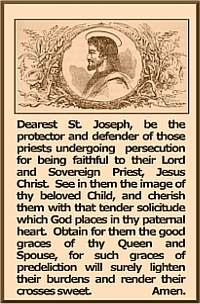AngelQueen has posted a lengthy and factual account of the Cristiada as written by Gary Potter who relies heavily on the authoritative text of the historian Jean Meyer. Below are some excerpts which I found to be especially interesting, but first here are the books which Mr. Potter recommends on the subject: The Cristero Rebellion; The Mexican People Between Church and State, 1926-1929 , by Jean A. Meyer (Cambridge University Press, 1976). Another work that can be recommended is Viva Cristo Rey! The Cristero Rebellion and the Church-State Conflict in Mexico , by David C. Bailey (University of Texas Press, 1974).
_____________________________________________________
… Here and there individuals and groups strive to keep alive the idea of Christian social order. Their very existence keeps the nearly universal sway of the Revolution from becoming total. That is on the one hand. On the other, by keeping the idea alive now, they also make it possible for Christian social order to be revived when God decides the time for that is come. [My emphasize; the triumph of the Immaculate Heart of Mary. It will come!]
An Encouraging Example
The story that follows may be of some encouragement. It is the story — told far too briefly — of Mexico’s Cristeros, Catholic peasants who did not accept that the Revolution was their movement. They rose in arms against it in their country, and by their very fighting and dying in the number they did, gave the lie — like the Vendeens in France and the Carlists of Spain — to the notion that the enemy owed its past and present success to “the people.”
The story of the Cristeros, alas, is not one of victory. That does not make it less than inspiring, however, for if they finally laid down their arms, they did not really surrender to the Revolution against which they fought. Militarily they had brilliant successes, and that they could ultimately have prevailed in the field is possible.
Betrayed they were. Ultimately, however, they fought for themselves, for their families, for their way of life, for what they believed . If they were compelled to stop fighting short of victory, their cause was not defeated, and certainly not “lost.” It remains alive in the minds and hearts of many Mexicans who still believe as did the Cristeros. It remains alive in much the way that, to many Americans, the Southern cause (the cause of a hierarchically-ordered society rooted in the land, faithful to custom and tradition, clinging to honor, and contemptuous of political expediency) is not “lost” even if the armed struggle for an independent nation to embody it ceased in 1865.
Again, because Meyer is who he is, we know he is not making it up when he describes other actions of federales : “The acts of sacrilege were surrounded by an atmosphere of horror85 Churches were desecrated by officers who rode into them on horseback, trampled the Host under the hoofs of their chargers, used the altars as dining-tables and turned the building into a stable. Statues of saints were used for target practice, and those of the Virgin were undressed and the soldiers danced with them. The soldiers dressed up in the ecclesiastical vestments, and ate the consecrated Hosts and drank cafE au lait from the chalice.”
Reflect on the ghastly pictures Meyer puts before our mind’s eye. Do not stop with the thought, “No wonder the Cristeros rebelled!” No, reflect also that many, if not nearly all, of the soldiers performing the acts would have been Catholic, would have been baptized, would have been First Communicants as young boys. Can we imagine the guilt that many must have felt? No doubt some were driven to committing further bestial acts in a desperate effort to obliterate the feeling. On the other hand, we may find here an explanation of why an army that stood at 70,000 men on paper actually suffered 20,000 desertions a year during the three years the war lasted.
That still more federales than Cristeros were killed despite their machine-guns, artillery and airplanes, all of which the Cristeros lacked, tells us something about the latter’s fighting skills, but we shall speak of that a little later.
Women’s Brigades
There is another aspect of La Cristiada that wants to be discussed, especially after our mention of Madre Conchita and also the perpetual problem the Cristeros had in finding ammunition and the money to buy it. This is to speak of the role women played in the rebellion, especially those of the Women’s Brigades. These amazing and courageous women — 25,000 of them, most unmarried and between the ages of 15 and 25 and commanded by “generals” none of whom was over 30, and nearly all of them peasant girls or working-class ones from the cities — deserve far more than the lines we shall give them. In truth, they deserve a book. It does not exist, and now probably never will. There are few records for an author to draw from since the women were too busy with their work to keep them, and there is no one to interview since all of the principals passed away years ago. There may be granddaughters with stories to tell, but how find them?
As the reader will glean from their very title, Women’s Brigades, these virtual female auxiliaries of the Cristeros organized themselves along military lines. Each brigade of 650 women was commanded by a colonel who was assisted by a lieutenant-colonel and five majors, each having under her captains, lieutenants and sergeants, with five soldiers under each sergeant. The main service they performed was providing ammunition to the fighters. Indeed, after the Cristeros twice gave money to the LNDLR to buy cartridges, only to see every centavo spent by the League to meet expenses of its own, they relied exclusively on the Women’s Brigades (except for what they captured from the enemy). What is extraordinary is that the women were able to operate in such complete secrecy that none were arrested until March, 1929, by which time they had existed nearly two years. One supposes the secrecy could be maintained, in part, because not a single defection from the Brigades’ ranks is known to have taken place.
Who They Were
The real nature of the rebellion is shown by the men who finally became its true leaders. As the peasants of the Vendee in France were led mainly by other peasants and artisans who demonstrated a surprising gift for military command, especially in guerrilla-type actions, the Cristeros found their most brilliant general in a man who was an itinerant salesman of pharmaceutical products before the rebellion. His name, still honored by Mexico’s Catholic patriots, was Jesus Degollado Guizar. Two other top generals were simple priests (both ethnic Indians) from rural parishes, Fathers Aristeo Pedroza and Jose Reyes. Other men with no military experience rose to command positions in an army that numbered 50,000 when it seemed on the brink of victory.
A few professional soldiers would fight with the Cristeros. The most illustrious, an artilleryman who became a general in the regular Mexican army at age 40, was Enrique Gorostieta. Incredibly, he was an agnostic, even a Freemason. Why exactly he had quit the army before the Cristero rebellion, and then joined the revolt, is not clear. He was an ambitious man and may have dreamed of a successful military career leading to political power. Did he leave the regular army because his career there was not leading him in that direction after all? Did he imagine Cristero victory might? It hardly matters. What does is that his service with the Cristeros led to his becoming Catholic and dying heroically.
It was the comportment of his men off the battlefield, but especially under fire, that converted the military professional. That is, the commander was filled with admiration for the men he commanded. This can be gleaned from numerous remarks he made over time to subordinates and fellow officers. What made the Cristeros the men they were? he asked himself. It was their Faith, he concluded. So he embraced it.
We shall let Jean Meyer describe what Gorostieta witnessed when he beheld the Cristeros in action: “Soldiers in sandals and dressed in white linen, still filled with the communal spirit of their village, of their field, of their private undertakings, of their family, [who] held steady under fire, did not hesitate to respond to supreme demands, and before his eyes crossed that line beyond which one no longer loves oneself, beyond which one no longer thinks of preserving one’s life. He saw them stand up and march calmly to the battle, hurl themselves machete in hand on the Federal machine-guns, and scale heights at the summit of which simple peasants begin to appear to us as great warriors.”
Intense Anti-Catholicism
As for Calles himself, ….
“Calles was a violent and passionate adversary of the Roman Church, not because he wished to prevent the latter from extending its influence and power, but because he had decided to extirpate the Catholic Faith from the soil of Mexico. What was so fundamental in his character, was that he was a man of principle, possessed of an energy which did not stop short of obstinacy and cruelty, and he was prepared to attack not only persons but also principles and even the institution itself, and that the system of government which, as a result of his philosophical convictions, he supported, condemned as economically and politically disastrous the very existence of the Church.”
________________________________________
It is a fascinating account which I would encourage you to read in its entirety.



